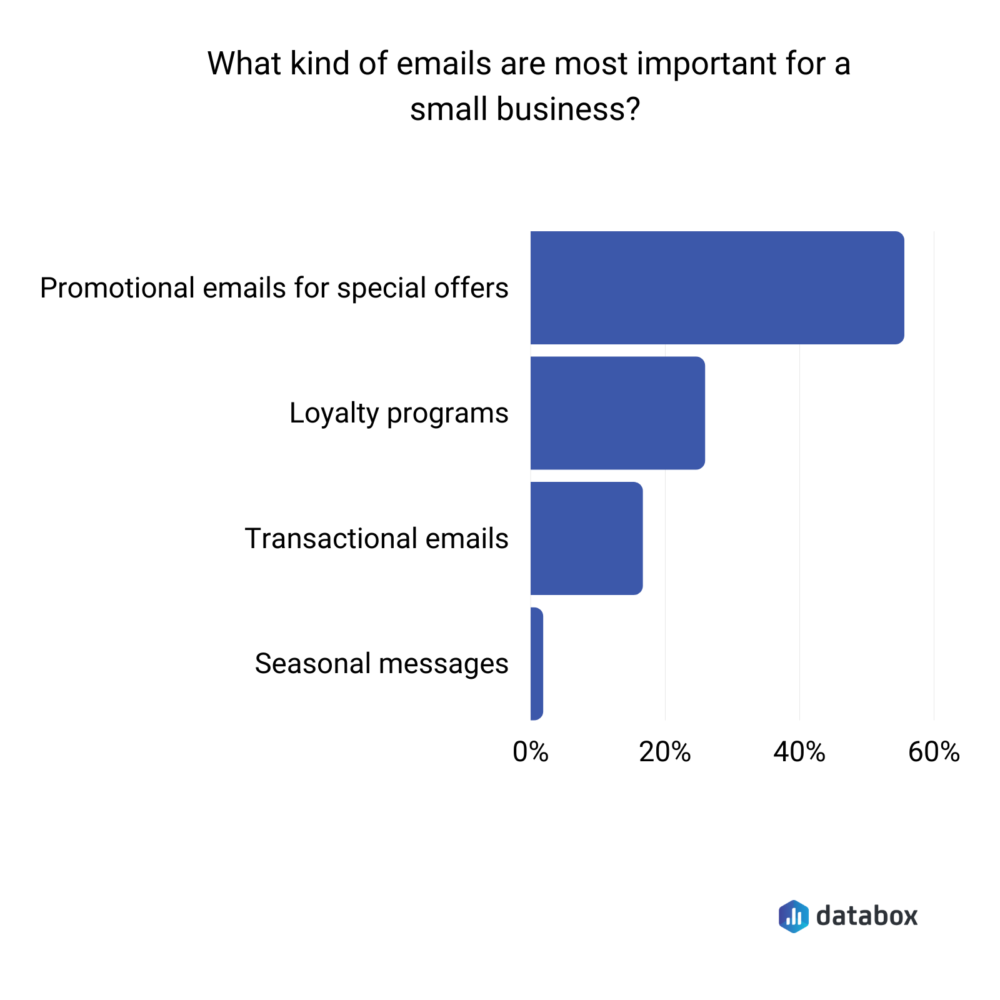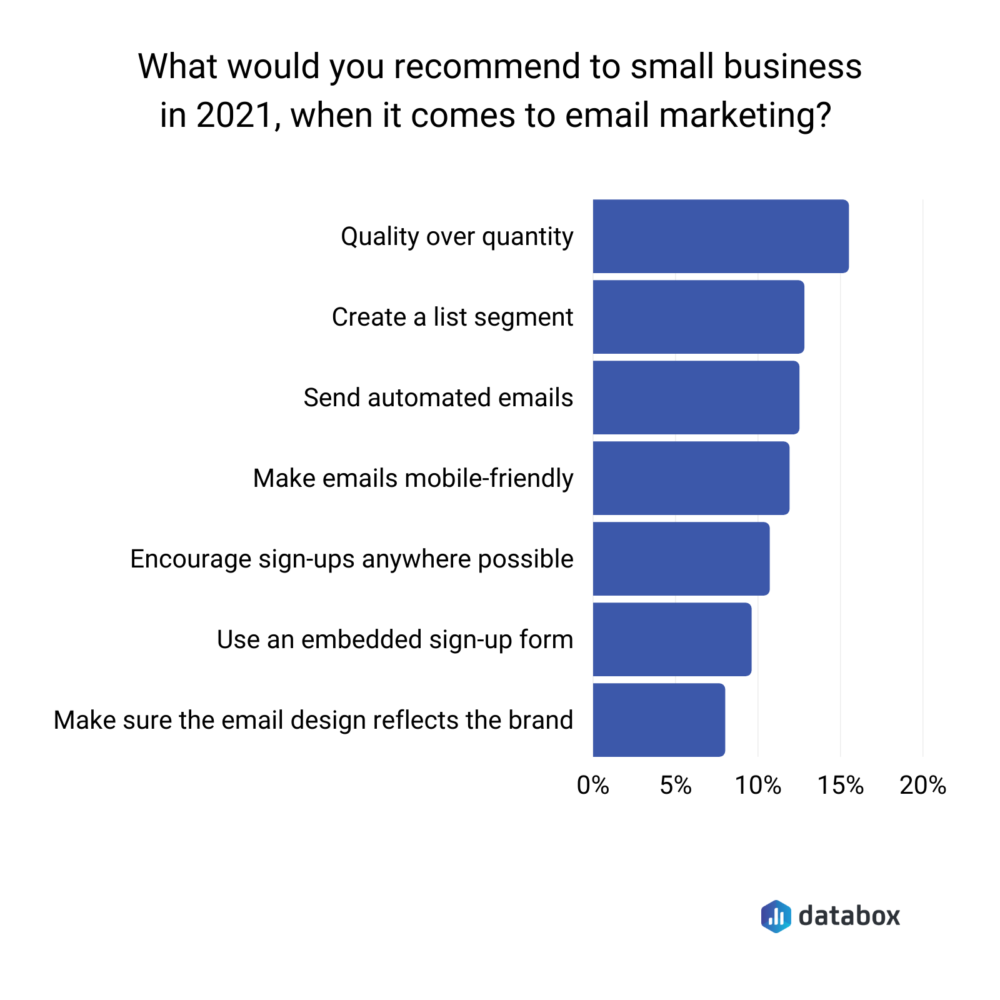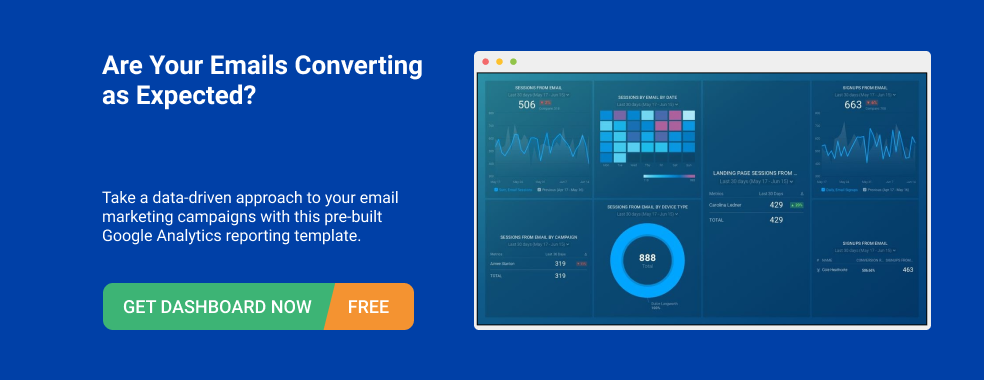Table of contents
As a small business owner, you are in a unique position to benefit from email marketing. Unlike large corporations that often don’t resonate well with small communities, you can build trust with local customers much faster, develop your reputation as a local expert, and more.
But how and where should you start? Blasting a ton of random, promotional emails that aren’t tied together by a strategy never helps anyone. So, what does?
We asked 50+ email marketers to share their best advice. Here are the 9 tips they shared.
- Be consistent with your emails
- Strike a balance between promotional and nurturing emails
- Email niche and unique content
- Make it personal
- Keep it short
- Use FOMO to your advantage
- Optimize emails for mobile readers
- Segment your list
- Create an email workflow
Now, for the details.
1. Be Consistent with Your Emails
Ever noticed brands that only show up in your inbox around Black Friday, Christmas season, and other sale seasons? I bet you have – we all have. The point here? Don’t be that brand.
Showing up as a fair-weather friend (read: sales-weather friend) means your subscribers are likely going to ignore your emails. To top that, you can’t create loyal customers with an inconsistent email frequency.
The solution? Establish an email frequency – a hat tip to PaidSearch.Pro’s Anthony Chen.
“Oftentimes I have seen businesses send out emails only when there’s an upcoming promotion or if customers abandon carts,” observes Chen.
“If you really value your customers, it’s important to have a full communication funnel email strategy,” they advise. “It’s also important to know when to stop. Setting a frequency cap or suppressing the subscribers who never open your email is also a good strategy to ensure you are not overwhelming your email list with promotions and risk potentially getting marked as spam.”
Put simply, show up consistently, but be sure to outline an email cadence that’s neither too infrequent nor overwhelming.
PRO TIP: Track Your Email Marketing Performance with Ease
Unsure what’s working in your email marketing strategy and what doesn’t? Feeling overwhelmed by data scattered across multiple platforms and reports?
Get a clear and centralized view of your campaign performance with our free email marketing dashboard templates – pre-built with essential metrics and KPIs from the most popular email marketing platforms, all in one place. See what’s working (and what’s not) with your email marketing, optimize campaigns, and maximize your return on investment.
Monitor engagement: Keep tabs on essential metrics such as open rates, click rates, and subscriber growth. Learn how your audience interacts with your emails and optimize your strategies accordingly.
Optimize campaigns: Identify your top-performing campaigns and landing pages with templates such as the Mailchimp Campaign Performance and HubSpot Marketing Performance dashboards. Analyze user activity, conversion rates, and campaign ROI to drive better results.
Understand traffic sources: Dive deep into your traffic data with the Website Acquisition Overview template from Google Analytics 4. Monitor where your users are coming from, their behavior on your site, and how it all ties back to your email campaigns.
Improve deliverability: Track your email delivery rates, open rates, and click rates to ensure your messages are reaching your audience and performing well.
You can easily set it up in just a few clicks – no coding required.
To set up a dashboard, follow these 3 simple steps:
Step 1: Choose a fitting template
Step 2: Connect your data
Step 3: Watch your dashboard populate in seconds
2. Strike a Balance Between Promotional and Nurturing Emails
When we asked our community of experts what kind of emails they consider most important for a small business, more than 50% chose promotional emails.

But how many promotional emails should you send per week? According to our contributors, balance is key here. You don’t want to come across as overly promotional. At the same time, you want to be engaging with your email list – having two-way conversations.
It’s why Benjamin Sweeney from ClydeBank Media suggests you send “periodic messages that don’t ask anything of your customers and just provide value” in addition to promotional and transactional emails.
“Tips on how to save money or get the most out of your products (without an overt sales pitch),” for example “are an excellent way to keep your brand current in the minds of your customers and to work toward building a positive brand association.”
The takeaway? You need a healthy “mix of lead nurturing, promotional, transactional, and value-forward messages to keep subscribers engaged as well as meet business goals.”
Jonathan Aufray from Growth Hackers Marketing is of the same view. “For your small business email marketing strategy, you want to create drip email sequences to send to your subscribers. However, you don’t want to be too salesy with your emails,” Aufray warns.
“What you want to do is to share interesting and insightful content that resonates with your audience. Those emails are called nurturing emails. Then, from time to time, it’s recommended to send a salesy kind of email.
But, don’t just send salesy emails because your subscribers will be bored with them and you will feel desperate. I usually recommend sending 4 nurturing emails for 1 salesy one.”
Measure the performance of your email campaigns using these email marketing dashboards.
3. Email Niche and Unique Content
Since a good email marketing strategy for small businesses covers nurturing emails, it’s essential you focus on ‘value.’
The best way to go about offering the most value is to answer the following question that Conversion.AI’s Alex Birkett recommends: “what’s in it for the audience?”
“Stand out and provide something interesting they can’t get elsewhere. Else, why would they sign up in the first place, and more pertinently, why would they stay on your list?” Birkett points out.
“People get too many emails. Don’t crowd up their inbox with boring stuff. If you ever send an email without asking, ‘what’s in it for the audience,’ don’t send it.”
Nikita Agarwal from Milestone Localization agrees. “The best email marketing strategy for a small business is sending niche and interesting content to subscribers on a regular basis.
Instead of just sending information about your promotions and your business, send analysis on the industry, interesting facts, and latest news.”
As an example, Agarwal shares their monthly newsletter. “We have a monthly newsletter which typically includes one report, one video, and three articles related to our industry
This keeps customers engaged and increases the open rate. If you’re always sending promotional emails, people unsubscribe or send it straight to trash.”
If you’re curating content, it’s also important you don’t simply share links and call it an email. Instead, share some context, add your opinion, or tell what’s interesting about it.
At Modestfish the team has had success by taking the time to thoughtfully share links. According to Emma Alda from the team what they did was simple: “we focused on one thing to turn the tides of our email marketing, and that was to create the same level of content that we offered on our website.”
“That means unique and immersive content,” Alda explains. Here’s how they did it. “Instead of 1 very long email, we made the choice to put the meatiest parts of 5 of our new articles in every newsletter, and always leave them on a cliffhanger to the main topic.
This allows us to reel in a diverse audience, whether it be someone who visits our website for the products or someone who frequents us for the tips and hacks in our industry.”
4. Personalize Your Emails
For small businesses to win at email marketing, it’s also essential you show off your brand personality. Put another way, make it human.
As Birkett puts it, “speak more colloquially. If you’re a small business, you have the unique advantage of less red tape and a perceived closeness with your customer that large companies can’t mimic (it comes off as artificial at that stage if they try). So give value and talk like a human (a friend, at that).”
Box Out Marketing’s Tyler Garns is of the same opinion. “Keep it personal. People buy from people, not corporations. Reduce the branding and write in a very personal manner to the individual. Just because you’re sending broadcasts to large groups of people, doesn’t mean it can’t feel personal to each person.” You can measure the impact of your email personalization efforts in growing your small business with this business dashboard software.
Related: Email Personalization: Tips, Tools, & The 6 Fundamentals For Success
5. Keep Your Emails Short
Alongside showing up regularly, it’s essential you don’t take much of your readers’ time. Sure, long newsletters can do well – but only if you have an established audience that wants to hear from you.
However, if you’re only starting out or just tapping into email marketing, you’ll want to keep your emails short as Christian Adams from Coffee Affection advises.
“It’s hard enough to get and maintain people’s attention these days,” notes Adams. “If you’re a small business just starting out, the unfortunate fact is that most people won’t be interested in reading what it is you have to say in an email, especially if it’s incredibly long.”
So it makes sense to “keep it short and to the point and use headers to get the main ideas across and it will work out in your favor.”
Related: 9 Proven Strategies for Improving Your Email Click-Through Rate (CTR)
6. Use FOMO to Your Advantage
Want a tip for writing high-converting small business emails? Mostly Blogging’s Janice Wald has one for you. “The best email marketing strategy is for small businesses to appeal to FOMO, the fear of missing out,”
“The best place to do this is in the subject line. Use trigger words to entice people to open your emails,” Wald explains. “‘Limited-time,’ ‘Limited quantities,’ and ‘Going fast’ are examples. This will make people feel urgencies and act on that feeling by opening your emails.”
Use this small business dashboard software to measure the effectiveness of this strategy.
7. Optimize Emails for Mobile Readers
It’s also essential that before you dip your toes into email marketing for your small business, you “optimize emails for mobile readership,” Alina Clark from CocoDoc recommends.
“Coupled with heavy personalization, a mobile-optimized email has the ability to convert more than one with no mobile optimization.
The last thing you want, as an email marketer, is to have your subscribers reading emails that don’t look good on phone. With more than 50% of email recipients being phone users, it only makes sense that one invests in making their emails mobile-friendly.”
8. Segment Your Email List
“To succeed at email marketing as a small business, you have to really understand your subscribers and try to personalize your messages to their needs as much as possible,” highlights Alicia Blessing from OuterBox.
“Too often, we see clients mass blasting their entire database with the same message, which typically results in low open rates and engagement.” However, Blessing explains, “the best email marketing campaigns are effective because they are customized to your subscriber’s unique needs.”
“So how do you develop highly customized email campaigns? Through email segmentation,” recommends Blessing.
“Email segmentation can take many forms but at the most basic level, you’ll want to segment your lists based on:
- How they have engaged with you
- What they tell you about themselves
In terms of creating email segments based on how your subscribers have engaged with you, you’ll want to look at everything from their purchase history to their engagement with your email campaigns, and even their website activity.
These types of insights can help you to create incredibly tailored campaigns for both special one-time offers or an automated series.”
That said, you can also segment subscribers by directly asking them about their interests. To this end, “consider adding a few questions to your sign-up form that will help you build advanced segments later on. “
But remember “you don’t want to overwhelm your users with a million questions.” Therefore, “adding one or two to your sign-up form is often a great way to help you tailor your messages down the road.” Alternatively, send surveys to your subscribers asking for their feedback on your newsletter while sneaking in questions about their interests.
Like Blessing, most of the experts we surveyed recommend email segmentation as one of the most effective email marketing tactics for a small business, along with sending quality, targeted emails and automating your campaigns.

Speaking of segmenting emails, Irene Dimakides from Megaventory suggests you “target well” by leaning on “heavy filtering, even if it seems counterintuitive.”
Here’s why: “When people know your emails are valuable and personal to them, they are more likely to open them and actually read them in the future,” observes Dimakides.
“To target well, we use automatic tagging as well as manually adding tags that are relevant to our business and client demographic. This ensures that the personalization of an email goes beyond the simple targeting of age, location, general interests, etc.”
9. Create an Email Workflow
Lastly, a lot of our contributors recommended creating an automated email workflow as one of the best email marketing strategies for small businesses.
“A particularly effective strategy is the use of automated emails,” insists Paul French from Intrinsic Executive Search.
“These are highly targeted, pre-written emails automatically sent to potential clients when they take certain actions while interacting with your brand.”
Here’s how these emails can help you: “As a small business owner with limited resources, automated emails can save you time while allowing you to engage with your audience throughout their purchasing journey and afterward.
Instead of writing individual emails to individual customers each time someone interacts with your brand, you set the parameters to trigger the appropriate email for each action. Automated emails are also trackable, allowing you to A/B test and analyze the effectiveness of your message.”
Elevate Delta 8’s Keeon Yazdani is of the same opinion. “An email marketing strategy that works well for small businesses is email automation flows. In a CRM like Klaviyo, email flows can be easily set up and segmented toward subscribers who have taken a particular action on your website.”
To explain this further, Yazdani shares an example. “A small business could have a welcome series flow, a post-purchase flow, an abandoned cart flow, and more. The emails within each flow can be different and can consist of educational content, user-generated content reviews, discount codes, and more.”
For small business email marketing, focus on following a consistent email schedule – sharing value-packed promotional and nurturing emails. Make sure you segment your list so you can send relevant content to subscribers. And, don’t forget, aim to build strong relationships with your subscribers – that’s what will help you grow your business and loyal customers. You can measure the impact of your email marketing efforts in growing your small business with this small business dashboard.
















